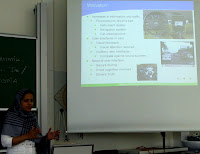 Ali presented our joint work with Nokia Rearch and DoCoMo Eurolab in the paper on sharing emotions [1] (the acceptance rate was about 20%). The research is motivated by the question how we can make communication more emotional and how we can enable digital craft creating. The idea is to have a new communication medium were a communication item is hand crafted and can carry emotion. The questions were encouraging and we hope to continue to work on this topic.
Ali presented our joint work with Nokia Rearch and DoCoMo Eurolab in the paper on sharing emotions [1] (the acceptance rate was about 20%). The research is motivated by the question how we can make communication more emotional and how we can enable digital craft creating. The idea is to have a new communication medium were a communication item is hand crafted and can carry emotion. The questions were encouraging and we hope to continue to work on this topic.
 In the poster session we had two contributions. Christian Winkler showed his project on Flash-light interaction [2]. The idea is simple: a camera in the environment or screen tracks the flash light of the phone – but it is very effective.
In the poster session we had two contributions. Christian Winkler showed his project on Flash-light interaction [2]. The idea is simple: a camera in the environment or screen tracks the flash light of the phone – but it is very effective.
 Ali presented a poster on a new poker table; this is a project some of our students build last term. An interesting aspect is that the playing cards are on the phone, the table is a multitouch table, and interaction is based on gestures (on the table as well as with the phone).
Ali presented a poster on a new poker table; this is a project some of our students build last term. An interesting aspect is that the playing cards are on the phone, the table is a multitouch table, and interaction is based on gestures (on the table as well as with the phone).
Have look at the table of contents of the entire conference to get an overview of current work in mobile HCI.
[1] Shirazi, A. S., Alt, F., Schmidt, A., Sarjanoja, A., Hynninen, L., Häkkilä, J., and Holleis, P. 2009. Emotion sharing via self-composed melodies on mobile phones. In Proceedings of the 11th international Conference on Human-Computer interaction with Mobile Devices and Services (Bonn, Germany, September 15 – 18, 2009). MobileHCI ’09. ACM, New York, NY, 1-4. DOI= http://doi.acm.org/10.1145/1613858.1613897
[2] Alireza Sahami Shirazi, Christian Winkler, Albrecht Schmidt: Flashlight Interaction: A Study on Mobile Phone Interaction Techniques with Large Displays (Poster). In: Adjunct Proceedings of the 11th international Conference on Human-Computer interaction with Mobile Devices and Services (MobileHCI’09) – Poster. Bonn, Germany 2009.
[3] Alireza Sahami Shirazi, Tanja Döring, Pouyan Parvahan, Bernd Ahrens, Albrecht Schmidt: Poker Surface: Combining a Multi-Touch Table and Mobile Phones in Interactive Card Games (Poster).In: Adjunct Proceedings of the 11th international Conference on Human-Computer interaction with Mobile Devices and Services (MobileHCI’09) – Poster. Bonn, Germany 2009.

















